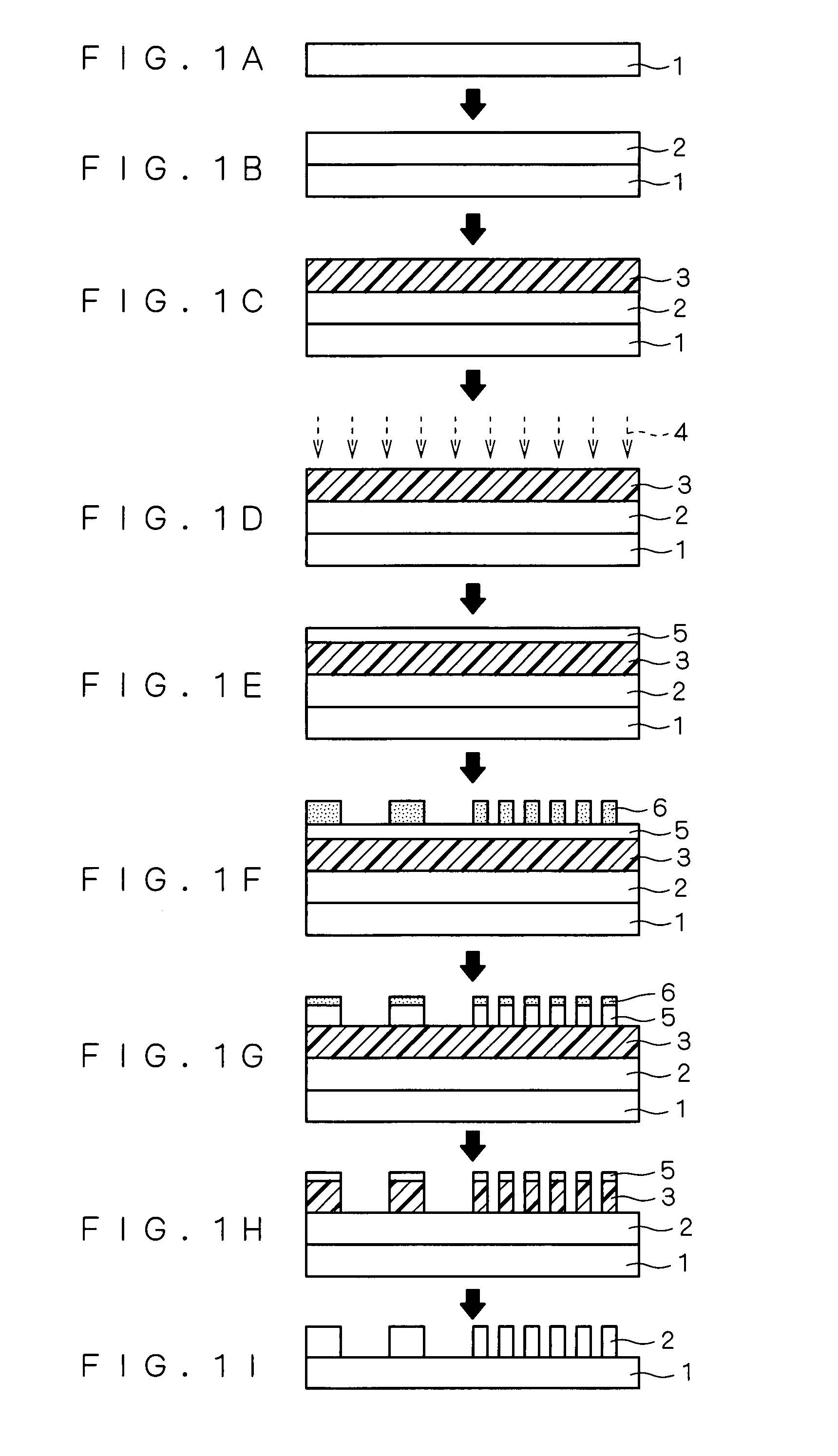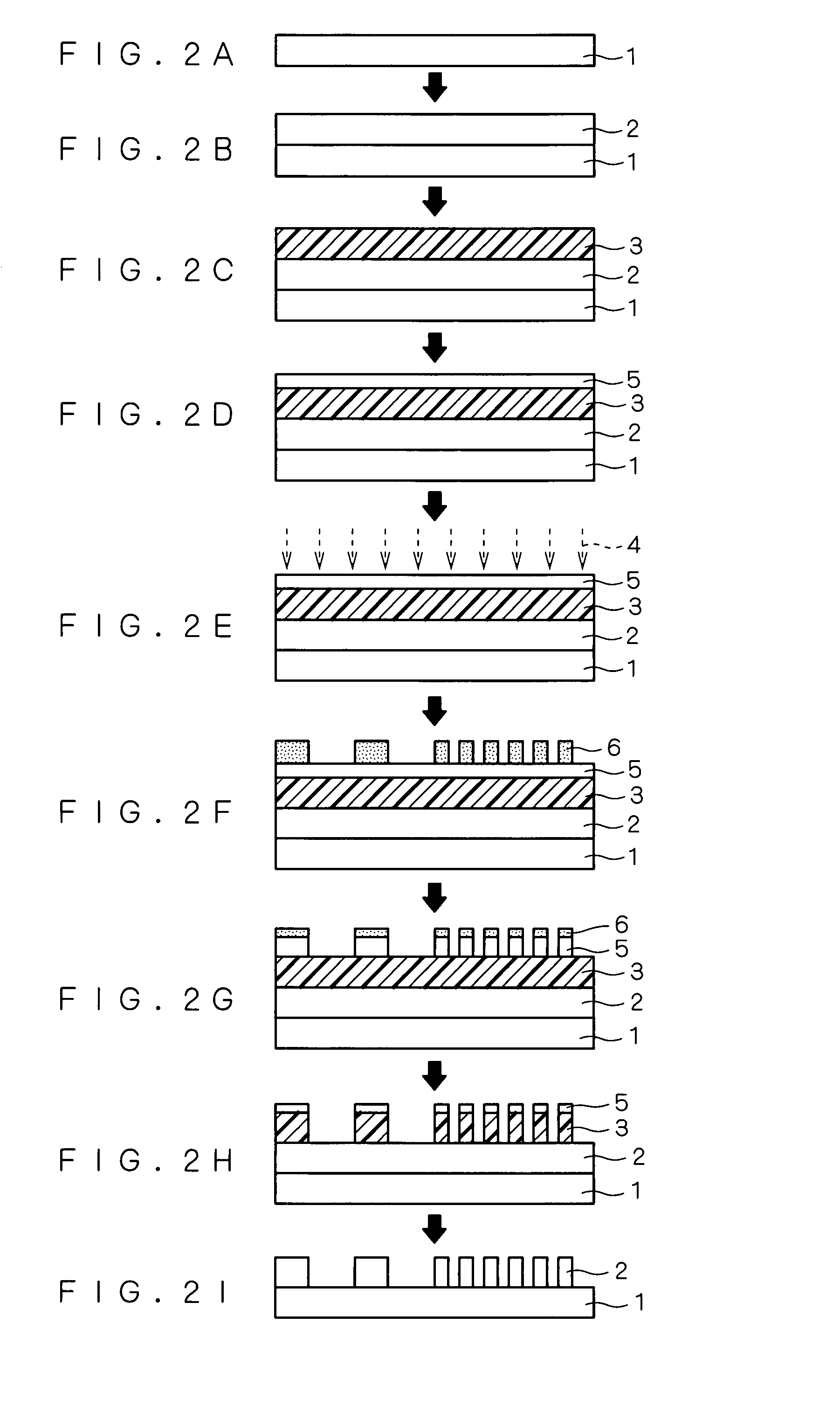Manufacturing method of semiconductor device
a manufacturing method and semiconductor technology, applied in the direction of electrical appliances, decorative surface effects, decorative arts, etc., can solve the problems of high accuracy, thickness of etching masks, and difficulty in forming fine resist patterns by lithography, so as to reduce the roughness of the pattern and reduce the deterioration of the processed configuration
- Summary
- Abstract
- Description
- Claims
- Application Information
AI Technical Summary
Benefits of technology
Problems solved by technology
Method used
Image
Examples
first embodiment
[0035]FIGS. 1A to 1I are flowcharts to explain a manufacturing method of a semiconductor device according to this embodiment. First, a film to be processed 2 is formed on a substrate 1 (Si substrate and the like) shown in FIG. 1A by sputtering, CVD (Chemical Vapor Deposition) and the like (FIG. 1B). In FIG. 1C, a coating type of lower organic film 3 having a film thickness of about 150 to 300 nm is applied to the film to be processed 2 and then a heat treatment is performed at 200 to 250° C. for about 1 to 1.5 minutes. By performing the heat treatment for the low organic film 3, a solvent can be sufficiently volatilized through a heat hardening process by a thermochemical reaction and a crosslink can be formed in a polymer by the reaction at a heat reaction active site.
[0036]In FIG. 1D, hardening treatment 4 is performed such that any one of Ar, B, As, P, C and H is implanted to the lower organic film 3 after the heat treatment and the lower organic film 3 is carbonized (graphitized...
second embodiment
[0047]FIGS. 2A to 2I are flowcharts to explain a manufacturing method of a semiconductor device according to this embodiment. First, a film to be processed 2 is formed on a substrate 1 (Si substrate and the like) shown in FIG. 2A by sputtering, CVD and the like (FIG. 2B). In FIG. 2C, a coating type of lower organic film 3 having a film thickness of about 150 to 300 nm is applied to the film to be processed 2 and then a heat treatment is performed at 200 to 250° C. for about 1 to 1.5 minutes. By performing the heat treatment for the low organic film 3, a solvent can be sufficiently volatilized through a heat hardening process by a thermochemical reaction and a crosslink can be formed in a polymer by the reaction at a thermal reaction active site.
[0048]In FIG. 2D, a middle layer 5 is formed on the lower organic film 3 after the heat treatment. A silsesquioxane-type polymer such as inorganic SOG or organic SOG is used for the middle layer 5 and applied so as to have a thickness of abou...
third embodiment
[0060]FIGS. 3A to 3I are flowcharts to explain a manufacturing method of a semiconductor device according to this embodiment. First, a film to be processed 2 is formed on a substrate 1 (Si substrate and the like) shown in FIG. 3A by sputtering, CVD and the like (FIG. 3B). In FIG. 3C, a coating type of lower organic film 3 having a film thickness of about 150 to 300 nm is applied to the film to be processed 2 and then a heat treatment is performed at 200 to 250° C. for about 1 to 1.5 minutes. By performing the heat treatment for the low organic film 3, a solvent can be sufficiently volatilized through a heat hardening process by a thermochemical reaction and a crosslink can be formed in a polymer by the reaction at a thermal reaction active site.
[0061]In FIG. 3D, a hardening treatment is performed such that any one of Ar, B, As, P, C and H is implanted to the lower organic film 3 after the heat treatment and the lower organic film 3 is carbonized (graphitized). In addition, instead o...
PUM
| Property | Measurement | Unit |
|---|---|---|
| thickness | aaaaa | aaaaa |
| thickness | aaaaa | aaaaa |
| thickness | aaaaa | aaaaa |
Abstract
Description
Claims
Application Information
 Login to View More
Login to View More - R&D
- Intellectual Property
- Life Sciences
- Materials
- Tech Scout
- Unparalleled Data Quality
- Higher Quality Content
- 60% Fewer Hallucinations
Browse by: Latest US Patents, China's latest patents, Technical Efficacy Thesaurus, Application Domain, Technology Topic, Popular Technical Reports.
© 2025 PatSnap. All rights reserved.Legal|Privacy policy|Modern Slavery Act Transparency Statement|Sitemap|About US| Contact US: help@patsnap.com



